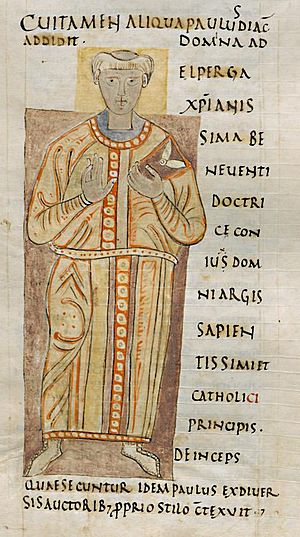Paul the Deacon facts for kids
Paul the Deacon (born around 720s, died April 13, 796-799 AD) was a famous Benedictine monk, writer, and historian. He was also known as Paulus Diaconus, Warnefridus, or Winfridus. His nickname "Diaconus" means "deacon," which was a religious role he held. He is best known for writing about the history of the Lombards, a Germanic people who ruled parts of Italy.
Contents
Life of Paul the Deacon
Paul's family came to Italy in 568 AD with Alboin, the King of the Lombards. They were given land near a place called Cividale del Friuli. Later, some of his family were taken away by the Avars, but one ancestor returned and rebuilt their family's wealth. Paul, whose birth name was Winfrid, was born around 720 AD in the Friuli region of Italy.
Early Education and Royal Connections
Because his family was important, Paul received a very good education. He likely studied at the court of the Lombard king Ratchis in Pavia. There, he learned some Greek from a teacher named Flavian. Flavian was probably a secretary for King Desiderius, who ruled after Ratchis.
King Desiderius's daughter, Adelperga, married Arichis II, the duke of Benevento. At her request, Paul wrote a continuation of a Roman history book. This book was called Summary of Roman History by Eutropius.
Life in Monasteries and with Charlemagne
Paul lived at the court of Benevento for several years. This was before 774, when Charlemagne captured Pavia. Paul might have left the city during this time.
Eventually, he joined a monastery near Lake Como. Before 782, he moved to the famous Benedictine monastery of Monte Cassino. There, he met Charlemagne, who was a powerful Frankish king. Around 776, Paul's brother, Arichis, was taken prisoner to Francia after a revolt. Five years later, when Charlemagne visited Rome, Paul wrote to him asking for his brother's freedom. Charlemagne then released Arichis.
Paul's writing skills impressed Charlemagne. He became an important part of the Carolingian Renaissance, a period of renewed interest in learning and culture. In 787, Paul returned to Monte Cassino. He died there on April 13, probably in the year 799.
Works of Paul the Deacon
Paul the Deacon wrote several important books and other texts. His writings give us a lot of information about his time.
History of the Lombards
Paul's most important work is his Historia Langobardorum (History of the Lombards). He wrote this book after 787, but no later than 795–96. It has six parts and tells the story of the Lombards. It starts from their legendary beginnings in the north and describes their journey to Italy in 568–69. The history ends with the death of King Liutprand in 744.
This book also includes much information about the Eastern Roman Empire, the Franks, and other groups. Paul wrote it from the Lombard point of view. It is especially useful for understanding how the Franks and Lombards interacted. He began his history by describing how northern regions are good for people:
The northern regions, being far from the sun's heat and cold with snow and frost, are healthier for people's bodies. They are also better for nations to grow. On the other hand, every southern region, being closer to the sun's heat, has more diseases and is less suited for raising people.
Paul used many sources for his history. These included an old document called the Origo gentis Langobardorum and other historical writings. He also used works by famous historians like Bede, Gregory of Tours, and Isidore of Seville.
Roman History Continuation
Paul also wrote Historia Romana (Roman History). This book continues the Breviarium by Eutropius. Paul's part covers the period from 364 to 553 CE. He wrote it in Benevento between 766 and 771.
Paul had suggested that Adelperga read Eutropius's work. She did, but she noticed that it didn't mention church matters and stopped in 364. So, Paul added parts from the Scriptures, church historians, and other sources. He added six books, bringing the history up to 553. This work was very popular in the Middle Ages. It is important because it shows an early view of the end of the Roman Empire in Western Europe.
Other Writings
At the request of Angilram, the Bishop of Metz, Paul wrote a history of the bishops of Metz up to 766. This was the first book of its kind in the region north of the Alps. It was translated into English in 2013.
Paul also wrote many letters, poems, and epitaphs (writings on tombstones). These included epitaphs for Duke/Prince Arichis II of Benevento and members of Charlemagne's family. Some of his poems were collected and published. One famous hymn, Ut queant laxis, was once thought to be written by Paul. This hymn's first syllables were later used by Guido of Arezzo to name the notes of the musical scale (ut, re, mi, fa, sol, la).
While Paul was in Francia, Charlemagne asked him to put together a collection of homilies (religious speeches). Paul did this after returning to Monte Cassino. This collection was widely used in Frankish churches. Paul also wrote two important homilies about the Assumption of Mary.
A book about Pope Gregory the Great is also believed to be written by Paul. He is also credited with translating a Greek story about Saint Mary the Egyptian into Latin.
See also
 In Spanish: Pablo el Diácono para niños
In Spanish: Pablo el Diácono para niños


